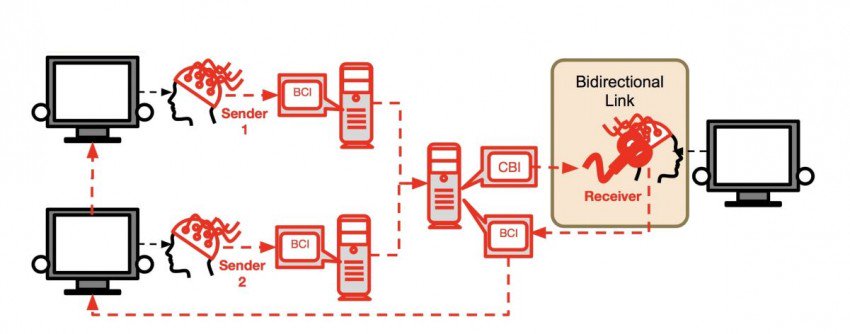We’re used to read about brain-to-brain communication in comic books or Science Fiction stories but it seems that we’re getting closer to actually making it a part of our lives in the future.
Andrea Stocco and his colleagues from the University of Washington in Seattle have been working on a set of tools that can ‘sense’ thoughts and transmit information about them into other brains. The team has been working on the project since 2015 and now they claim to have managed to achieve the world’s very first brain-to-brain network, which they have dubbed BrainNet.
The tools in question include, among other things, electroencephalograms (EEGs) and transcranial magnetic stimulation (TMS). EEGs record the electrical activity in the brain – they are electrodes placed on the skull which can pick up the activity in the brain, while the TMS transmit the information into the brain.
To test the network, Stocco and his colleagues connected three people – two senders that wear EEGs and one other person who is attached to both an EEG and a TMS. They are all placed in different rooms and cannot otherwise communicate but, allegedly, through the device.
The three people play a Tetris-like game – the two senders watch a full-screen where the game is designed ‘so the shape of the descending blocks fit in the bottom row either if it is rotated by 180 degrees or if it is not rotated‘. These senders will decide which option is needed and then send that information to the third member.
Now, when this happens, the signals their brains produce will vary and the EEG will move a cursor to the right hand side of the screen, if it senses a 15 Hz signal. When this happens, the device signals the receiver to rotate the block.
How do the senders control the signals, you ask? Easy – they stare at LEDs placed on both sides of the screen: one flashes at 15 Hz and the other at 17 Hz. Meanwhile, the receiver only sees the top half of the screen so they can only choose to rotate or not rotate the blocks according to the signals it gets from the senders.
During the trials, the researchers often changed the information from one sender in order to see if humans can figure out what to do when they are not getting enough data. According to the study, humans actually do manage to distinguish between real and false information just by using the BrainNet protocol.
So far, the system is pretty rudimentary, true, but the team hopes that this will prove to be the foundation that will pave the way for future networks that will become increasingly more accurate and complex.
Related: ✍️CES 2018: Nissan Is Working On Brain-To-Vehicle Interface✍️
Follow TechTheLead on Google News to get the news first.























